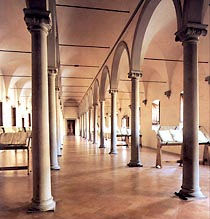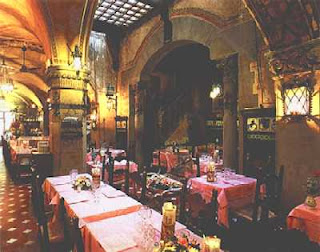After lunch on Saturday 18 November 2006 we hopped on the train to Florence. This was the first time we used our Eurail Pass and all went well. From the central station in Florence it was a short walk to the Hotel Botticeli.

The hotel, on a narrow street away from the main roads, was cozy and the staff friendly. However, just down the road there was about five trattorias and the noise from these eateries carried on until about 3 a.m. every night, and after that the rubbish trucks started their rounds, with numerous wine bottles being thrown out with many a mighty crash. After the rubbish trucks followed the street-sweeping trucks, so our nights were not very peaceful, but we survived. It was simply a matter of getting used to the ambient noises.
As soon as we were settled in the hotel we ventured forth, found the Museo di San Marco (Museum of Saint Marcus) and spent a delightful afternoon there enjoying the artworks.


We were particularly impressed by panels illustrating the key Bible stories, by the Miraculous Supper of Saint Dominic, and by the collection of bells.
The museum of San Marco in Florence comprises a church and an old Dominican monastery, restored and enlarged by Michelozzo under orders from Cosimo I de Medici.

During the 15th century the monastery was home to two famous Dominicans, the painter Fra Angelico and the preacher, Girolamo Savonarola. A famous collection of manuscripts is housed in the monastery library built by Michelozzo.

This famous fresco in one of the great halls of the Last Supper was painted by Domenico Ghirlandaio at the end of the 15th century.

We visited the austere cells where Savonarola lived and where Cosimo I went to meditate. Each cell of the monks’ cloister (and many other walls of the halls and rooms) were decorated with frescoes by Fra Angelico in collaboration with others, including Benozzo Gozzoli.

Fra Angelico demonstrates his understanding of linear perspective particularly in his Annunciation paintings. This large fresco stands at the top of the stairway leading to the cells of the monks.
Underneath the monastery we saw relics that were saved from the 19th century destruction of the original monastery, as well as a fascinating collection of bells. One of these bells, called La Piagnona, was particularly impressive because of its huge size and elaborate engraving.

San Marco is famous as the seat of Girolamo Savonarola's discourses during his short spiritual rule of Florence in the late 15th century. The citizens of Florence stormed the monastery to capture Savonarola when he was condemned for heresy. The bell was taken from the monastery and carried through the city while it was beaten with whips of leather as a symbolic punishment.

We had dinner at the "Paoli Antico Ristorante" on Via dei Tavolini and enjoyed it immensely. The restaurant is situated in an old building with beautiful pillars and interesting ceilings, and a row of tiles with the coat of arms of different Italian families, set in wood panelling, surrounding the interior at about chest-height. The waiters were a band of older chaps, obviously all good friends, who have been working together at the same restaurant all their lives. The food was great. I had "Ossi Buchi" with Beans and Willem had his favourite "Bistecca a a Fiorentina" (T-bone steak) with fries and spinach.

Odd things we noticed in Florence is that cyclists do not have to wear helmets, and window flower boxes contain Cyclamens, not the usual Geraniums. I discovered that finding my way around the old part of Florence was really hard, because the buildings are tall, the land is flat and the streets are narrow, so one cannot see any distant landmarks as guidance.
We were once again struck by the beautiful doors to the buildings in the old part of the city. This one was of very well-preserved wood and had awesome lion's head knockers.


We found the traffic flow in Florence more civilized than in Rome. Drivers would stop politely for pedestrians at crossings and for a change pedestrians would obey the traffic lights. This is what our tour guide on the trip to the Chianti said about road signs in Italy: "In the north of Italy road signs are regulations, in the middle road signs are suggestions, and in the south road signs are decorations".

On one of our walks along the streets of Florence we came across this beautiful caroussel at the Piazza Repubblica. It was fairly early in the morning and the street-sweepers were still busy tidying up the Piazza after some event was held there the previous evening. Note how the buildings around the Piazza are reflected in the mirrors along the top of the caroussel.

No comments:
Post a Comment